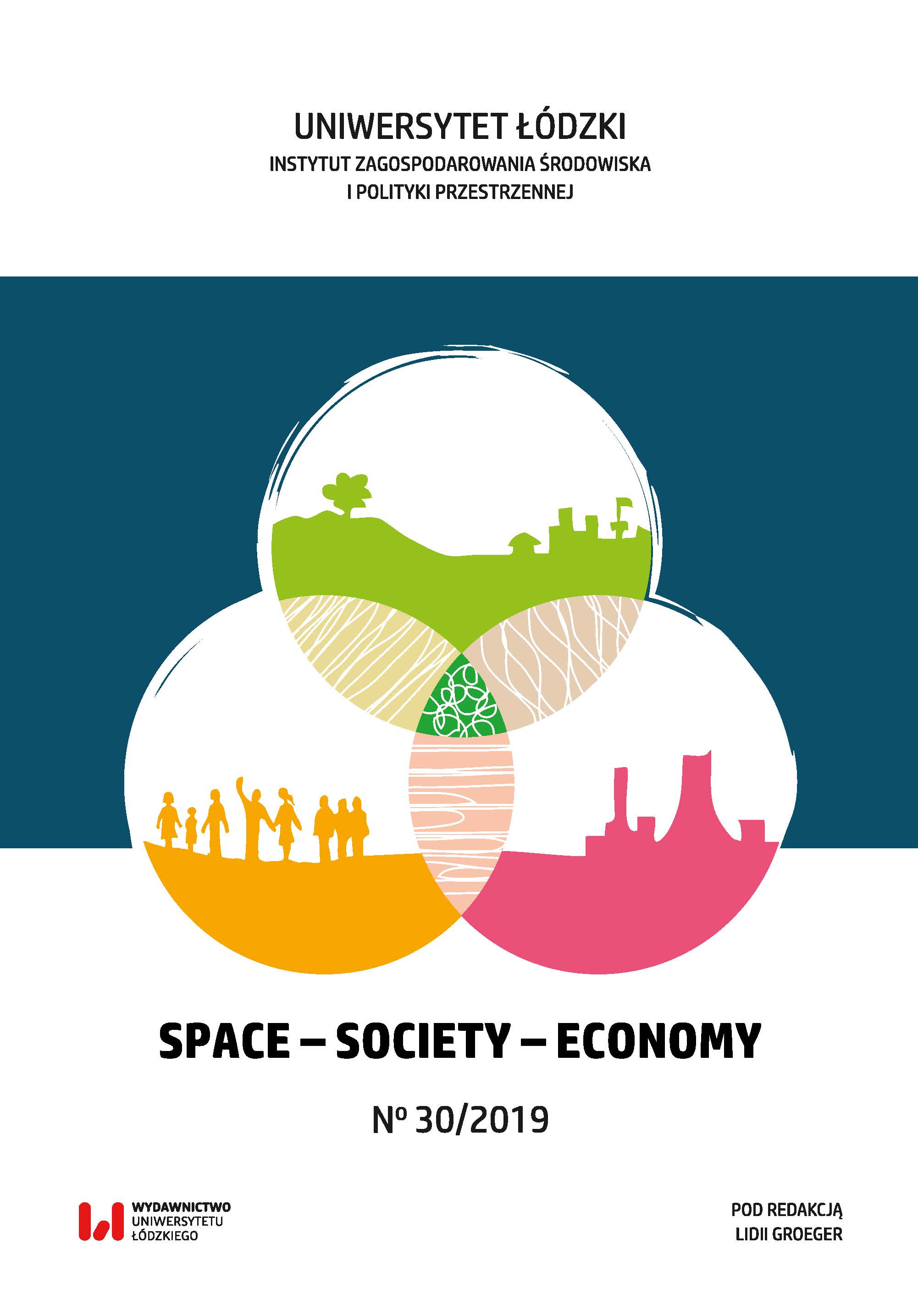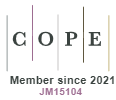Diversity of market square buildings and their functions in the context of genetic types of market squares in small cities of the Lodz Voivodeship
DOI:
https://doi.org/10.18778/1733-3180.30.02Keywords:
town square, public space, morphogenesis of towns, small cities, Lodz VoivodeshipAbstract
The aim of the study is to assess the public space of market squares in small towns of the Lodz Voivodeship diversity in the field of spatial development and the function of buildings around the town square. The goal and scope of the research is primarily dictated by small numer of similar studies in the literature on the subject. Recalling the genetic context of the elements of the urban structure is to constitute a starting point for reflection on contemporary differences in the spatial development and functions of buildings around the town square. In the paper were used methods from landscape research, city morphology and functionalism (functional structure). The most important data sources were urban inventories and historical maps from the 19th century and the first half of the 20th century. The level of market square opening was assessed as well as the existing structure of the residential and service function according to gross floor area. In this respect, large variations were noted in the group of researched town squares. In some of the cities studied, the small number of buildings around the town square is still affected by the destruction of World War II. In the majority of the cities studied, services are the dominant function in buildings around the town square. The exception is the economically weakest Krośniewice, where the residential function dominate. The influence of historical factors, as well as the demographic and economic potential of cities, is noticeable on the contemporary condition of buildings around market square and its functions.
Downloads
References
Adamczewska-Wejchert H., Wejchert K., 1986, Małe miasta. Problemy urbanistyczne stale aktualne, Wydawnictwo Arkady, Warszawa.
Google Scholar
Bursiewicz N., 2018, Regeneration of market squares in historic town centres: Ideas, discussion, controversies, „Urban Development Issues”, 60: 67–79.
Google Scholar
DOI: https://doi.org/10.2478/udi-2018-0036
Czarnecki B., 2003, Plac rynkowy współczesnego małego miasta w Polsce na przykładzie Białostocczyzny, Wydawnictwo Wyższej Szkoły Finansów i Zarządzania w Białymstoku, Białystok.
Google Scholar
De Lotto R., Sturla S., 2017, Measure and proportion as keyword for qualitative town squares, „The Journal of Public Space”, 2 (1): 69–80.
Google Scholar
DOI: https://doi.org/10.5204/jps.v2i1.51
Gadomska E., 2011, Podstawy architektury krajobrazu, Część III, Wydawnictwo Hortpress, Warszawa.
Google Scholar
Gargała M., Lichołai L., Pisarek M., 2014, Kierunki przekształceń rynków małych miast Podkarpacia wynikające z nowych trendów gospodarowania przestrzenią, [w:] Wybrane zagadnienia z problematyki gospodarowania przestrzenią, „Problemy Ekologii Krajobrazu”, 37: 59–69.
Google Scholar
Gehl J., 2010, Cities for people, Island Press, Washington–Covelo–London.
Google Scholar
Groeger L., 2009, Rzgów – zagospodarowanie przestrzenne nowego miasta w województwie łódzkim, „Acta Universitatis Lodzensis. Folia Geographica Socio-Oeconomica”, 10: 125–139.
Google Scholar
Ilnicki D., 2009, Przestrzenne zróżnicowanie poziomu rozwoju usług w Polsce. Teoretyczne i praktyczne uwarunkowania badań, Instytut Geografii i Rozwoju Regionalnego, Uniwersytet Wrocławski, Wrocław.
Google Scholar
Jastrząb T., 2002, Place i rynki jako zagadnienie urbanistyczne, Wydawnictwo Politechniki Poznańskiej, Poznań.
Google Scholar
Kaika M., Karaliotas L., 2016, The spatialization of democratic politics: Insights from indignant square, „European Urban and Regional Studies”, 23 (4): 556–570.
Google Scholar
DOI: https://doi.org/10.1177/0969776414528928
Konecka-Szydłowska B., 2016, Ocena przestrzeni publicznej małych miast aglomeracji poznańskiej, „Problemy Rozwoju Miast. Kwartalnik Naukowy Instytutu Rozwoju Miast”, 12 (3): 5–12.
Google Scholar
Kononowicz W., Pisera I., 2018, Problemy rewitalizacji małych miast na przykładzie Międzyrzecza, „Budownictwo i Architektura”, 17 (1): 13–20.
Google Scholar
DOI: https://doi.org/10.24358/Bud-Arch_18_171_02
Kosiacka-Beck E., Rykała E., Żołnierczuk M., 2017, Fenomenologiczna interpretacja w kształtowaniu przestrzeni na przykładzie wnętrza placu rynkowego, „Zeszyty Naukowe Uczelni Vistula”, 53 (2): 115–129.
Google Scholar
Koter M., 2015 (1974), Fizjonomia, morfologia i morfogeneza miasta. Przegląd rozwoju oraz próba uściślenia pojęć, [w:] Barwiński M. (red.), Geografia historyczna i polityczna w badaniach Marka Kotera. Wybór prac, Wydawnictwo Uniwersytetu Łódzkiego, Łódź.
Google Scholar
Kozakiewicz S. (red.), 2003, Słownik terminologiczny sztuk pięknych, hasło: rynek, Wydawnictwo Naukowe PWN, Warszawa.
Google Scholar
Krzysztofik R., 2007, Lokacje miejskie na obszarze Polski : dokumentacja geograficzno-historyczna, Wydawnictwo Uniwersytetu Śląskiego, Katowice.
Google Scholar
Kulawiak A., Szmytkowska M., 2018, Geograficzny aspekt badań nad przestrzenią publiczną miast w Polsce, „Biuletyn KPZK PAN”, 271: 75–92.
Google Scholar
Kulesza M., 2001, Morfogeneza miast na obszarze Polski Środkowej w okresie przedrozbiorowym: dawne województwa łęczyckie i sieradzkie, Wydawnictwo Uniwersytetu Łódzkiego, Łódź.
Google Scholar
Langstraat F., Van Melik R., 2013, Challenging the ‘End of Public Space’: A comparative analysis of publicness in British and Dutch Urban Spaces, „Journal of Urban Design”, 18 (3): 429–448.
Google Scholar
DOI: https://doi.org/10.1080/13574809.2013.800451
Lorens P., 2014, Rozdział: Tkanka miejska, [w:] Lorens P., Martyniuk-Pęczek J. (red.), Wprowadzenie do projektowania urbanistycznego, Akapit-DTP, Gdańsk: 24–41.
Google Scholar
Marszał T., 1995, Szadek. Monografia Miasta, Zarząd Miasta i Gminy Szadek, Szadek.
Google Scholar
Mehan A., 2016, Blank slate: Squares and political order of the city, „Journal of Architecture and Urbanism”, 40 (4): 311–321.
Google Scholar
DOI: https://doi.org/10.3846/20297955.2016.1246987
Mehta V., 2014, Evaluating public space, „Journal of Urban Design”, 19 (1): 53–88.
Google Scholar
DOI: https://doi.org/10.1080/13574809.2013.854698
Miszewska B., 1994, Bloki urbanistyczne Wrocławia w różnych fazach cyklu miejskiego, [w:] Koter M., Tkocz J. (red.), Zagadnienia geografii historycznej osadnictwa w Polsce. Materiały konferencyjne, Toruń–Łódź: 111–129.
Google Scholar
Miszewska B., Szmytkie, R., 2015, Morphological processes in the spatial structure of the southern district of Wrocław city, [w:] Szymańska D., Rogatka K. (red.), „Bulletin of Geography. Socio-Economic Series”, 27: 133–151, Toruń.
Google Scholar
DOI: https://doi.org/10.1515/bog-2015-0009
Polska A., 2011, Oceny estetyczne krajobrazu, „Prace Komisji Krajobrazu Kulturowego Polskiego Towarzystwa Geograficznego”, 15: 185–192, Sosnowiec.
Google Scholar
Saterus P., 2013, Leksykon urbanistyki i planowania przestrzennego, Wydawnictwo BEL Studio, Warszawa.
Google Scholar
Sikorska M.E, Sobierajska I., 2016, Problemy rewitalizacji placu miejskiego w Węgrowie. Mazowsze, „Studia Regionalne”, 19: 31–47.
Google Scholar
DOI: https://doi.org/10.21858/msr.19.02
Słownik geograficzny Królestwa Polskiego i innych krajów słowiańskich, Tom IX, 1880– 1914, Warszawa.
Google Scholar
Suliborski A, 2016, Koncepcja strukturalno-funkcjonalna w geografii człowieka, [w:] Maik W., Suliborski A., Wójcik M. (red.), Nowe i stare perspektywy i ujęcia w geografii na przełomie XX i XXI wieku, Seria: Podstawowe idee i koncepcje w geografii, 9: 103–121, Wydawnictwo Uniwersytetu Łódzkiego, Łódź.
Google Scholar
DOI: https://doi.org/10.18778/8088-505-9.07
Suliborski A., 2016a, Genetyczno-systemowe ujęcie funkcji i struktury funkcjonalnej miasta, [w:] Wójcik M. (red.), Miasto – region – tożsamość geografii. Wybór prac Andrzeja Suliborskiego, Wydawnictwo Uniwersytetu Łódzkiego, Łódź: 69–75.
Google Scholar
Suliborski A., 2016b, Koncepcja funkcji miejsca, [w:] Wójcik M. (red.), Miasto – region – tożsamość geografii. Wybór prac Andrzeja Suliborskiego, Wydawnictwo Uniwersytetu Łódzkiego, Łódź: 77–96.
Google Scholar
Teles R.P., Gomes da Silva M.L., Cordeiro R.M., 2019, Comfort and welfare assessment of public squares in the municipality of Crato-Ce, „Revista Ciencia e Sustentabilidade”, 5 (1): 123–141.
Google Scholar
DOI: https://doi.org/10.33809/2447-4606.512019123-141
Van Melik R., Van Aalst I., Van Weesep J., 2009, The private sector and public space in Dutch city center, „Cities”, 26: 202–209.
Google Scholar
DOI: https://doi.org/10.1016/j.cities.2009.04.002
Wejchert K., 1947, Miasteczko polskie jako zagadnienie urbanistyczne, Wydawnictwo Ministerstwa Odbudowy, Warszawa.
Google Scholar
Wejchert K., 1984, Elementy kompozycji urbanistycznej, Wydawnictwo Arkady, Warszawa.
Google Scholar
Wojnarowska A., 2016, Model of assessment of public space quality in town centres, „European Spatial Research and Policy”, 23: 81–109.
Google Scholar
DOI: https://doi.org/10.1515/esrp-2016-0005
Wojnarowska A., 2017, Jakość przestrzeni publicznej centrum miasta. Przykład miast średnich regionu łódzkiego, Wydawnictwo Uniwersytetu Łódzkiego, Łódź.
Google Scholar
DOI: https://doi.org/10.21858/msr.21.03
Yang W., Kang J., 2005, Soundscape and sound preferences in urban squares: Case study in Sheffield, „Journal of Urban Design”, 10 (1): 61–80.
Google Scholar
DOI: https://doi.org/10.1080/13574800500062395
Zakariya K., Harun N.Z., Mansor M., 2015, Place meaning of the historic square as tourism attraction and community leisure space, „Procedia – Social and Behavioral Sciences”, 202: 477–486.
Google Scholar
DOI: https://doi.org/10.1016/j.sbspro.2015.08.196
http://polski.mapywig.org/
Google Scholar
https://bdl.stat.gov.pl (dostęp: 18.11.2019).
Google Scholar
https://geoportal.lodzkie.pl/imap/ (dostęp: 20.08.2019).
Google Scholar
https://sjp.pl/rynek (dostęp: 10.08.2019).
Google Scholar
Downloads
Published
How to Cite
Issue
Section
License

This work is licensed under a Creative Commons Attribution-NonCommercial-NoDerivatives 4.0 International License.









